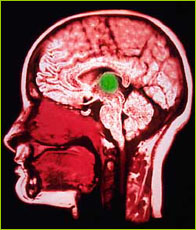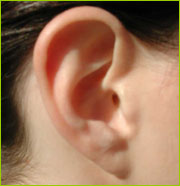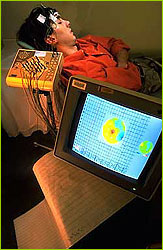|

|

|
|
The Electric Brain
Part 2 |
Back to Part 1
NOVA: How else can consciousness get damaged?
Llinás: The other thing that can happen is
that deep in the brain there is a structure called the
thalamus. If the thalamus is damaged—and this is a
central entity of the brain, some sort of gateway into the
brain—if the gate is damaged then you have the same
problems that you have with cortical damage. If the part of
the thalamus that connects to the visual cortex is damaged
then you don't see.
NOVA: So externally they'll look like the same
problem, or for the person they will feel like the same
problem?
Llinás: Absolutely the same. Even a
neurologist cannot tell the difference, so he or she will
have to do an MRI to see where the lesion is, either
cortical or thalamic. So this central nucleus, the thalamus,
and the cortex seem to be very deeply related. Consciousness
can be damaged at the cortex, at the thalamus, or at the
connections between the thalamus and the cortex. These two
levels are organized as a feedback system in which the
thalamus speaks to the cortex and vice versa in a
dialogue.
|
 The cortex, also known as "gray matter," is a
thickly folded band of tissue responsible for higher
mental functions. It is connected to the thalamus,
shown here in green, an older structure in the
center of the brain.
The cortex, also known as "gray matter," is a
thickly folded band of tissue responsible for higher
mental functions. It is connected to the thalamus,
shown here in green, an older structure in the
center of the brain.
|
NOVA: If the thalamus and the cortex weren't able to
"bind" all these different sensory inputs, what would the
world look like?
Llinás: It wouldn't look like anything. It
would be a hodgepodge of things, like when people drink too
much and get into problems of timing and cannot move
properly or think properly and see things that might not be
the way things actually are. You can also have binding
problems in neurology. A German colleague told me about a
patient diagnosed as having a psychiatric condition. When
they did a brain scan they found that she had a bilateral
lesion on the temporal lobe. The problem was that she
couldn't see things that were in motion, so things were
continually appearing and disappearing. If she had to cross
the street she would be terrified because she wouldn't see
cars coming.
NOVA: Until they stopped.
Llinás: Yes, but then they just appeared, and
where did they appear from? So she had a problem of binding
movement with objects. There are issues of binding that are
less complicated. For instance, some dyslexic children have
binding problems and so their timing is slightly off, they
think a little slower. To them everyday events happen a bit
too fast for them, a bit like action movies, so they have
problems following fast events or reading or even hearing
the sounds of words properly.
NOVA: This goes back to the concept of the brain's
need for rhythm?
Llinás: You need rhythm to put everything
together. It is like dancing. Rhythm tells you when to move
and at what speed to move, whether you are dancing a waltz
or doing the cha-cha. Likewise the brain has a rhythm. In
order to bind things many parts of the brain must fire and
be active together, and they must have a rhythmicity. By
having this rhythmicity—the thalamo-cortical
rhythm—they make one function into an event.
"Consciousness is soluble in a local anaesthetic or
even in alcohol."
|
|
NOVA: Is the binding, this rhythm, where
consciousness comes from?
Llinás: Yes. Binding allows the different
parts to be transformed into one cognitive experience. Now,
interestingly enough, all of these things can be dissolved
with a local anaesthetic. So if we put a local anaesthetic
in someone's visual cortex, although we are not damaging the
brain or changing the synapses or the neurons, the neurons
are now not capable of having electrical activity. That
function disappears. So consciousness is soluble in a local
anaesthetic or even in alcohol.
NOVA: How is this thalamo-cortical rhythm generated?
Llinás: The cells in the brain, like the
heart, have intrinsic rhythm. They move, they oscillate,
like the waves in the ocean at a certain speed, a certain
velocity, a certain frequency. Cells can have different
frequencies. They can oscillate very slowly, and when that
happens consciousness disappears. You are asleep, deep
asleep; you are not dreaming. Cells are negatively charged;
they are negative with respect to the outside world, by
about 60 to 70 millivolts. If the membrane potential, the
voltage across the membrane of the cells, is modified so it
becomes a little less negative, the rhythm of the cells
changes. They wake up. They oscillate at a high frequency.
NOVA: When you are asleep, how many times per second
do the cells oscillate?
Llinás: When we are asleep most neurons
oscillate at a very slow rhythm. That's how cells control
consciousness—by voltage, by becoming electrically
inactive or active. If you take a drug, if you fall asleep,
if you get hit in the head, the brain does not generate the
functional state that is you. The you disappears.
|
"I tell my students when they fall asleep that they
disappear."
|
NOVA: Your image of yourself disappears.
Llinás: Yes, but to you that's all that being
you is! I tell my students when they fall asleep in my
lecture that they disappear. Their body is there but they're
not there. As someone gently elbows them on the ribs they
reappear. This is known as waking up.
NOVA: If the thalamus is so important in maintaining
consciousness, can you trace specific psychiatric or
neurological disorders to problems in the thalamus?
Llinás: This is a beautiful story that is just
beginning to be understood now because it is such a
different point of view. Because of these rhythms, which are
known to be related to the sleep-waking cycle and which we
have been studying since the beginning of the last century,
we ask certain questions. I ask, for example, isn't it
incredible that we fall asleep as a single entity and then
wake up as a single entity? It would be a tragedy if you
were to wake up and you could see but you couldn't hear. The
system seems to be able to shut itself off as a whole and
turn itself on as a whole.
NOVA: What would happen if for some reason some part
just stayed off?
Llinás: If you look at Parkinson's patients,
they have a great deal of difficulty moving. They are almost
paralyzed—they walk with very small steps, have very
little facial expression—and they have tremors. It
turns out that their thalamic cell properties make these
cells oscillate at a low frequency—four to six times
per second—even when they are awake. One part of the
brain is asleep while the rest of the brain is awake. That
is a problem. These neurons are not dancing the right way.
There is friction between neighboring areas, one of which is
asleep and one of which is awake. Something called the edge
effect apparently occurs, that is, there is a discrepancy.
Some parts are stuck in a particular mode while the rest are
computing other things. We came to the conclusion that in
Parkinson's the inability to move in a coordinated manner
was created by the fact that the frequency of oscillations
did not allow for generation of proper movement orders to
the muscles. And the edge effect, in contrast, was a
continuous order to move.
NOVA: The edge effect—the continuous order to
move—causes the tremors?
Llinás: Yes. And if that is the case then if
you wake up the appropriate part of the thalamus this
problem should disappear. If you put an electrode in the
part of the thalamus that polarizes it, this problem should
immediately disappear.
NOVA: And this has been tried?
Llinás: Yes, we have spectacular films of such
results. You can see how when the person is stimulated the
results are immediate and the person begins to function. You
are bringing the circuit back into the correct timing by
either returning the cells to their correct rhythm or by
taking them out of the loop. So, the question is, what
happens if that occurs in another part of the thalamus? What
about focusing on a part that hears? What you would expect
to happen happens—the edge effect now produces a
sound, rather than a tremor. And what property does this
sound have? It is on all the time. It has a certain ongoing
frequency, like a persistent acoustic tremor. The person
hears something not from the outside but from a signal on
the inside. This is the case in tinnitus.
 Tinnitus, more commonly known as "ringing in the
ear," occurs in millions of people. People suffering
from this condition hear a sound even when no
external sound is present.
Tinnitus, more commonly known as "ringing in the
ear," occurs in millions of people. People suffering
from this condition hear a sound even when no
external sound is present.
|
|
NOVA: Ringing in the ear?
Llinás: Right. So what happens if something
like this happens in a part of the brain that feels
pain—the cingular cortex? What happens is that you
have central pain. Like when you lose an arm but the hand
that should be there hurts, you have a phantom limb. [For
more on phantom limbs see
From Ramachandran's Notebook.] If you put in an electrode, and you stimulate the
correct part of the thalamus, you get rid of the pain. And
what happens to depression? Same thing. Hallucinatory events
in the visual system are probably the same thing too. So
there are a whole lot of psychiatric and neurological
problems that might be related to a thalamo-cortical
dysrhythmia.
NOVA: Do you think that someday you might be able to
insert electrodes in the appropriate part of the brain to
solve all these different problems?
Llinás: Well, hopefully it is only a temporary
solution while we think of better ways to solve the rhythm
problem. A pacemaker with an electrode is a very rough
solution.
NOVA: Most people, it seems, don't view the brain as
electric—they view it as a big gland secreting
neurotransmitters. So that if you have an imbalance of
serotonin you might have depression, or if you don't have
enough dopamine, you have another problem—Parkinson's.
How do neurotransmitters fit into your view of the brain?
Llinás: Dopamine and serotonin work by
modifying directly and indirectly the electrical activity of
neurons. Too much or too little generates medical
conditions. With Parkinson's there is no dopamine. What
happens then is that the thalamus becomes hyperpolarized and
starts firing continuously. In the case of Parkinson's,
dopamine goes down, and then the thalamus begins to
oscillate, and you get tremors and paralysis.
NOVA: What other diseases might involve this timing
problem, or lack of rhythm, between the thalamus and the
cortex?
Llinás: We think that this thalamo-cortical
dysrhythmia is responsible for some types of epilepsy,
Parkinson's, depression, obsessive-compulsive disorder, some
aspects of schizophrenia, central pain, and tinnitus. They
are all part of the same disease.
NOVA: And you think this because you have seen
evidence of it?
Llinás: Yes.
|
 During an EEG, electrodes are placed on the scalp to
detect electrical impulses within the brain.
During an EEG, electrodes are placed on the scalp to
detect electrical impulses within the brain.
|
NOVA: How do you actually view these rhythms?
Llinás: You can either put the patients in an
instrument, like an EEG [electroencephalogram], or better an
MEG [magnetoencephalograph], or else you can put electrodes
in the thalamus during surgery and see abnormal activity.
NOVA: Supporters of biofeedback therapy have cited
your work as support for their theories of why biofeedback
could work in treating epilepsy. Does that make sense to
you?
Llinás: It makes a lot of sense. With
biofeedback, though, there's only so much you can do. If
someone had enough of an intact brain to reorganize, then
there would be hope. The best way to correct these things is
with specialized designer drugs that would go to specific
cells and change the properties.
NOVA: But there aren't many of those.
Llinás: Not at the moment, but rational drug
development in neuropharmacology will result in some, at
some point in the near future. We will dream some up. But
you have to know what the problem is first, right?
NOVA: So what is coming out of this research is not
necessarily pacemakers for the brain but more targeted
drugs?
"Pacemakers aren't my idea of heaven."
|
|
Llinás: Pacemakers aren't my idea of heaven.
It's the same with cancer treatment. These are molecular
problems, and we are attacking them with spoon- or
toothpick-sized tools. Obviously it's wrong, but that's all
we have. Rational drug design is what's going to happen. At
the moment we use drugs that hit everywhere, and so they
have unwanted side effects. There are bad side effects to
neurosurgery too and to having cables coming out of your
head. There are side effects in all of these things we do.
NOVA: Does the normal thalamo-cortical rhythm change
as you grow older?
Llinás: Yes, we have looked at that. Forty
hertz [number of cycles per second], or beta gamma band
activity, as it's known, is not as well organized with age.
There are low frequencies that begin to creep in. So people
don't hear so well, they have a little ringing in the ears,
and they don't see so well. You begin to see how the ability
to put things in time very crisply disappears. A 25-year-old
is agile, intelligent, sees things better, and can memorize
and remember better. He has the disadvantage of not having
experience, hence the saying, "if only the young knew or the
old could." The young don't know but they can and the old
know but they can't.
|
 Neuroscientist Rodolfo Llinás
Neuroscientist Rodolfo Llinás
|
NOVA: What do you think about this work that has come
out recently that suggests that the brain is always
generating new neurons?
Llinás: It's a bit controversial. I haven't
seen many people getting better with time. There's a very
good reason for it, by the way. The nervous system has its
own developmental history. Most of the nerve cells are as
old as we are, and they have known one another for as long,
so they have established their connectivity—they have
a common history. So if a new cell comes in, forget about
the new-kid-on-the-block problem. How are you going to give
functional context to that cell?
The nervous system doesn't repair itself for a very good
reason. It lacks context if it starts growing in all
directions. A paralyzed leg is a big problem, but worse than
a paralyzed leg is one that moves in the wrong direction or
at the wrong time. That one can easily kill you.
NOVA: Do you find, spending so much time thinking
about how the brain thinks, that it's hard, even when you're
not at work, to stop thinking about how how
your brain thinks?
Llinás: Sure. I find such thought fascinating
and often downright amusing. Esthetically the brain has been
beautifully assembled by evolution, and it's also,
fundamentally, about the nature of our own existence.
This interview was conducted by Lauren Aguirre, Executive
Editor for NOVA Online.
Photos: (1-2,5,7) Photo Researchers; (4) Corbis Images;
(6) Rob Meyer for WGBH; (8) Courtesy of Rodolfo
Llinás. Video Clip: David A. McCormick, Yale
University
Visual Mind Games
|
From Ramachandran's Notebook
|
The Electric Brain
|
Probe the Brain
Resources
|
Teacher's Guide
|
Transcript
|
Site Map
|
Secrets of the Mind Home
Search |
Site Map
|
Previously Featured
|
Schedule
|
Feedback |
Teachers |
Shop
Join Us/E-Mail
| About NOVA |
Editor's Picks
|
Watch NOVAs online
|
To print
PBS Online |
NOVA Online |
WGBH
©
| Updated October 2001
|
|
|
|